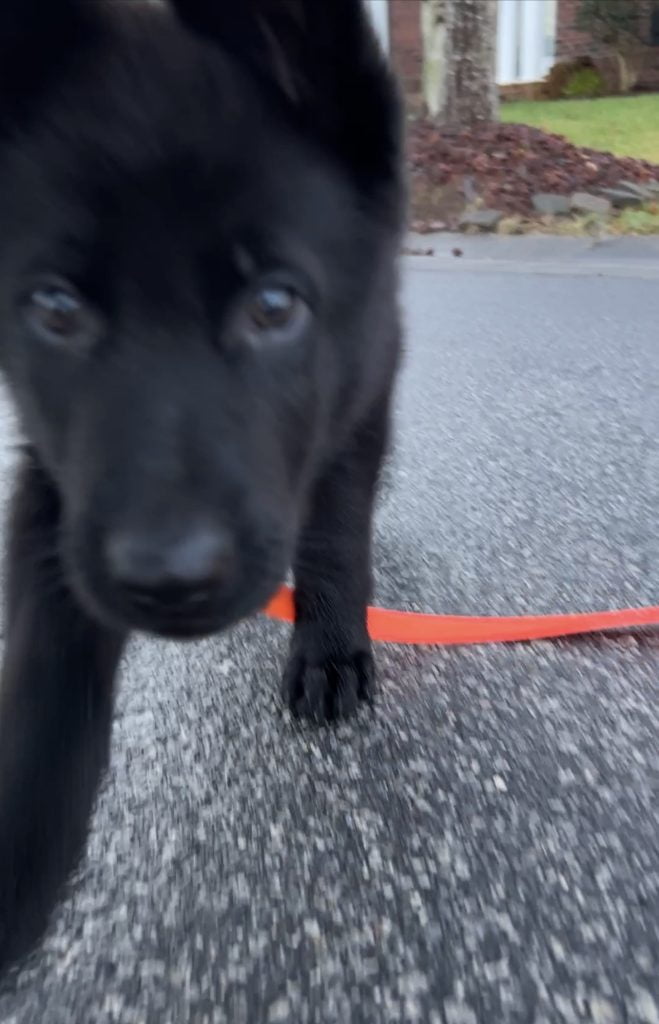
Today the sun was shining and bright and it was cold.
07:30am – He came out of the crate, squawked a bit and then we went to pee. After which we went back and he drank water and then we went on a short walk. As we walked into the front yard my friend Kathy came by with her dog Haven. We talked and she asked if the dogs could interact. Babe when to Haven – nose to nose – then ran away yelping.
Nothing happened but puppies get scared easily. And Haven is an adult Golden Poodle.
After Kathy left Babe was still yelping and barking and looking at Haven as they walked away. When he calmed down and came back to me, we continued our warlk. He had 2 good solid poops.
Then we went to the outside kennel and he had his breakfast – 1 cup of dry kibble. He yelled for less than 30 seconds after I put him back in the kennel..
11:30am – Session 1 we worked place for the first time, house, whistle recall, kennel and sit. He was absolutely incredible!!! He only ate about 1/2 cup of the dry kibble but he’s loving his hot dog (training treats) so I’m not concerned about how much he ate. He’s only been with us for less than 48 hours, as the travel leaves his body he will normalize. He yelled for less than 1 minute after I put him back in the kennel.
3:50pm – Session 2 we worked whistle recall, place, house, ultimate workout and name recognition. He is very very sharp. His prey drive is extremely high and he’s teething.
5:30pm – play time and dinner.
7:30pm – play time and walk.
9:30pm – play time and walk.
A few things to remember when you are training puppies.
Walking Your Puppy
Puppies love to run in between your legs or criss cross in front of you or criss cross as they run between your legs. It is extremely easy to step on your puppy or get tripped up. Here’s how to handle that: take small steps, walk slowly and keep your eyes focused down where you’re walking. Don’t talk to your neighbor who is cooing about the puppy – don’t take your attention off your puppy.
Leash Training
Everyone gets frustrated with their puppy on a leash. I mean why not? They’re small. They’re cute. They’re fluffy and cuddly. Unless you want to be carrying your full grown dog (Babe will be an 85 to 120 pound adult male) it’s best to let him get himself around. Put on a collar and attach a leash. My favorite leash is a retractable 24’ leash – the dog can go to the limit of the leash and as he runs back to you there is no tangle to deal with.
When you want to go to a specific place – for example the training field. Put on the leash and walk to the field. Your puppy may or may not want to go your direction. If he wants to go opposite of you, just let him. He’ll get to the end of the leash and pull. Then he’ll stop. Then he’ll come back to you and as he does you continue going where you were planning to. Under NO circumstances should you yank your puppy.
Dog On Dog Reactions
Be very mindful of the situation you’re putting your puppy into. Puppies should meet other dogs and puppies but you need to ensure that the other dog isn’t going to dominate them. Your puppy will have one of these reactions.
Fear
They will bark, put their tail between their tail and run back to you yelping. Making sure that the other dog wasn’t aggressive when your puppy comes back to you, give him an LRS (least reinforcing stimulus). Basically you ignore his outburst. If you give him any attention like “oh poor baby” and reach out to him, you are positively reinforcing reactivity. Don’t do that.
Indifference
This is the Holy Grail response. You want your dog to NOT react to any other dog around him. But that is a learned behavior – if your puppy does that naturally – you’re in a good spot. As you puppy shows indifference, give him attention, pet him and speak words like “good boy” softly.
Joy
They start hopping around and go into play mode. While this may appear to be good it’s the same as the fear response only the inverse of that. Meaning your dog is still being reactive. Because the opportunity to play with another dog is present you should ask your puppy for a control behavior. When he does that correctly his “reward” is getting to play with the other dog. Both dogs should be on leash unless they have a prior relationship. You want to be able to pull your puppy away if aggression starts. There is a very fine line between aggression and play.
Leadership
Dogs descended from wolves. Wolf community is based on the boss – Alpha and then everyone else. You have to be Alpha in all situations! That doesn’t mean dominate your puppy, it just means that you should remember you are the boss and your word is law. Adherence to your law get positive reinforcement and ignoring your law gets an LRS.
That is why you must be in the right state of mind when you are training a puppy. You can’t be harsh but you also can’t be so lovey dovey that the puppy thinks he’s in control.
